How can we manage wet clothes and gear when we work in places not geared up to coping with the aftermath of outdoor activities? I’ve been rummaging through my collection of photos and here’s some ideas. Please do chip in, if you have any other good solutions or coping mechanisms.

Firstly in the above photo, from the Nature Pre-school in Seattle, cheap plastic crates have been turned on their side and tied together. This ultra-economical approach is fine if you do not have to dry clothes. At this nursery, all the children’s belongings are removed daily as the place is also used by an out of school care club. So parents take home wet clothes and dry them. You need to prep parents in advance if it’s part of the expectation of your nursery to deal with wet and muddy clothing. Some parents use large bags and the children stand in these to peel off their outer layers before stepping out of the bags and into clean outer gear.
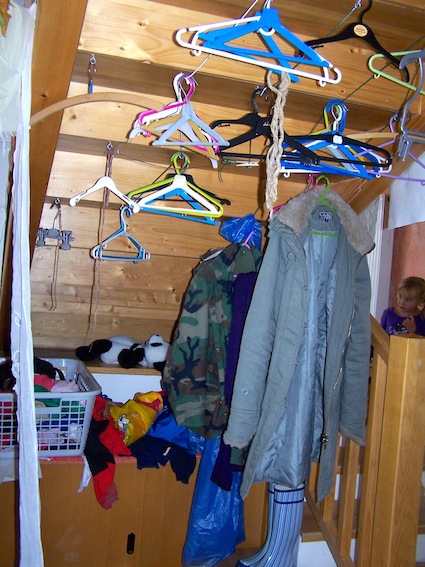
At the Toulcuv Dvor Nursery in Prague, another economical approach had been taken. Washing lines on hooks were hung under the stairs. Clothes were hung up on the hangers. I liked this simple, space-saving solution. When I returned 9 years after my first visit, the nursery had invested in a substantial amount of cloakroom space. I particularly liked the little yellow wooden steps to support the access to staff clothing hung on the hangers.

In one outdoor nursery in the Czech Republic I saw a cost-effective approach using hangers with storage space. Each child had their own unique design.
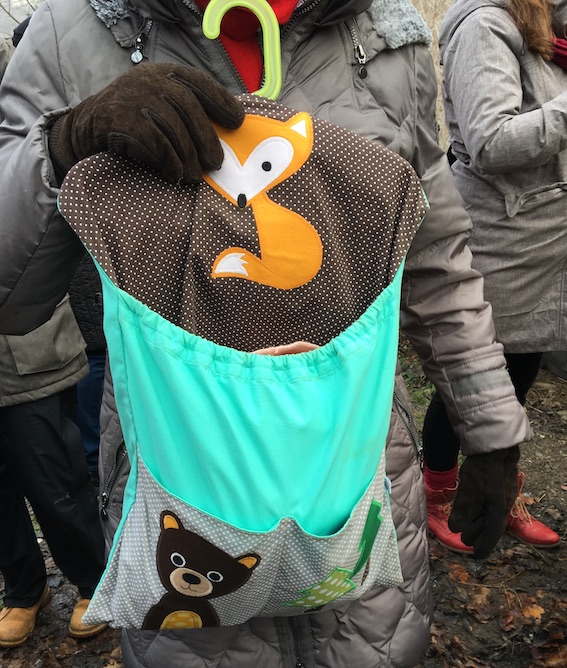
This is what the storage system looked like inside their yurt:

Having any cloakroom area situated beside the entrance to the outdoor space is a sensible move. Sadly this can be forgotten by architects and planners when designing schools. At my previous school we used cloakroom trolleys – and just wheeled in the “cloakroom” to beside the door leading to the outside space. A big carpet which can absorb the wet drips and mud also helps.

In the photo above, from Utsikten Primary School in Sweden, the circle on the door is filled with plastic overslippers for guests arriving who do not wish to remove their shoes. This does help keep the indoor floors clean.

At Mulleborg I Ur och Skur Nursery, the entrance to the outdoor space was clearly designated as shown above. When children come inside from outdoors, their boots must be removed before leaving the benched off area. I liked the space for wellies stored under the benches. Also check out the child-sized wellyboot remover, complete with holding bar. On and above the radiators there are drying racks and pockets for gloves etc. Remember to check your country’s fire exit regulations to ensure that you are complying with the access requirements of the set up you wish to have.
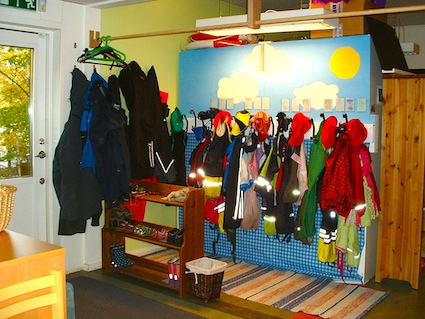
When space is limited and there’s lots of wet clothing, having several approaches can be possible. At Havskatten I Ur och Skur, there is a drying rack above, clothing on the side and this rather smart drying cabinet. Would I be wrong to call it like a “hot fridge”? These are available in the UK too. You need to read up carefully as there are a huge range of types and prices. Some need to simply be plugged in, others need installation. Here’s an example.

The one similarity I noticed between all the I Ur och Skur schools and nurseries I visited was the cloakroom systems. In the photo below, you can see this nicely. There is usually space for boots at the foot. Above this, each child has 4 pegs for their outdoor gear. Above this is a cubby for storing hats, gloves, etc. Finally on top is a box or basket for spare clothes. This is where parents check daily and remove wet clothes and replace with dry spares. Also look at the use of a traditional clothes pulley. Wet clothes left at the end of the day are hung up to dry – lifted up and into the warmer air at the top of the room.
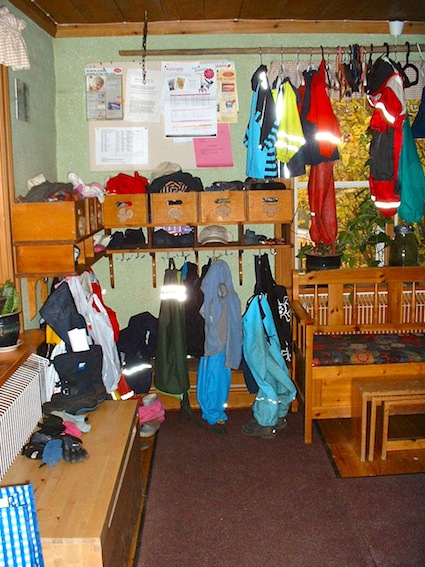
Common sense says that the more children learn independent routines, the easier it is for everyone to manage this aspect of learning and playing outside. This does take time to embed but the effort is worth it especially as the children grow older. Having dustpans, brooms and brushes about to enable children to sweep and tidy can be part of the fun too. Several years ago when visiting Iceland it was encouraging to see the classes of 2-3 years being supported to dress and undress independently. Yes it took time but the effort invested was worthwhile.
Outdoor approaches
Some nurseries decide to invest in outdoor cloakrooms that are adjacent to their main building. Whilst this is fine in warmer climates, it does mean that in winter children are changing in and out of kit in a cold place and that items take longer to dry. Swings and roundabouts! It may be the only way of making it manageable in some settings.

Lost property in outdoor settings
The washing line approach seems to work well. At Upper Sturt Primary near Adelaide,, the parent noticeboard is immediately adjacent to the lost property that is hung up. This seems a lot more helpful than a box tucked away in a remote part of the school.
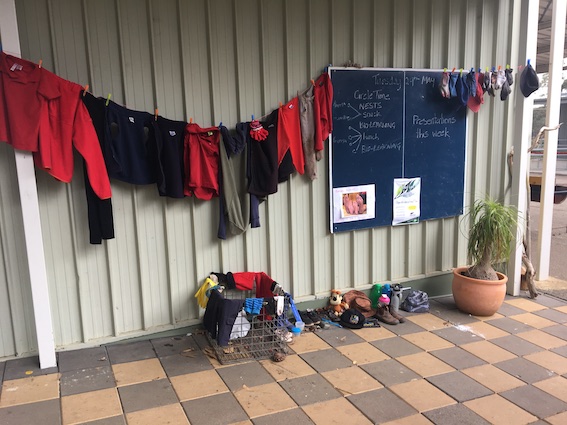
At Stramash Fort William Outdoor Nursery, the lost property is also pegged up at the nursery entrance. It’s in an undercover area as it really is a rainy part of the UK. I love that the design includes space for water bottles…!

One little product that Stramash Elgin have put in lots of places outside has been peg carousels. They have these in lots of their sheltered spaces so that all the mitts can be put up to dry promptly. Thank you Sasha Cameron for this information 🙂

Portable mud management systems
Whilst these have been international examples of cloakrooms and storage systems, there are some great approaches in Scotland and the British Isles. Many nurseries have hoses near the entrance where children can hose each other down in their waterproofs before coming inside. In one particularly muddy outdoor patch, the nursery had developed a very sophisticated system. It involved having a big carpet area outside and several washing bowls. The children stepped in a bowl of water first of all. Next they wiped their boots on the outdoor mat before moving to the indoor mat for a second wipe and boot removal.
Below is another example – in this one, the children use the spa taps and water in a container to scrub off mud prior to going inside. This is the portable system I would set up when working with a nursery. The bucket in the tyre had a range of scrubbers so that it was a way of developing children’s physical motor skills as part of the process, having choice and learning about what worked well for washing themselves down at the end of a session.

Drying room
Stramash Fort William Outdoor Nursery have invested in a drying room which has been a game changer. Fort William is one of the dampest, wettest parts of Scotland. The drying room is spacious, warm and welcomed by children, staff and parents. At the end of a wet day, children and staff can leave their soggy outdoor clothes at nursery where they dry overnight. The next day, the gear is warm and ready to use. Parents and staff do not have to manage wet clothing at home other than the occasional wash. In fact it reduces the temptation to overwash outdoor clothing which is never a good idea as it wears out the waterproof barriers in many types of outdoor clothing. A numbered peg system is in place so that each child and their family know which clothes belong to them.
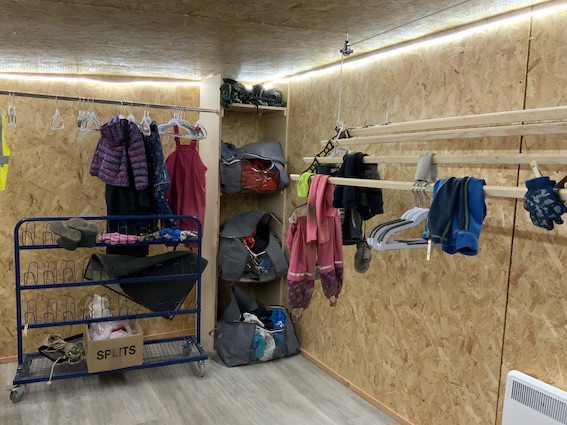
Commercial cloakroom solutions
There are now many commercial offerings of different cloakrooms based on these models. If you are purchasing these, check the number of pegs being offered per child. With outdoor gear, I have found that children need a minimum of 2 pegs each . The pegs also need to be of a design that children can easily use and which also keep the clothes on the pegs. It’s very frustrating to be constantly picking up clothing that won’t stay put. Likewise the amount of space offered per child matters. Some pegs or cubbies are squashed too close together. Other things to watch are the height of the pegs and accessibility by children. Ask to see a video clip! Remember children will also need space to remove or put on their outdoor kit as well.
This blog post is an updated version of one that originally appeared in October 2013.




















Always good to get the children involved int he clearing up as well as the play. A few wet days are fine, but the smell of constant dying gear is not so good but very hard to avoid.
Yes – one of my intentions when I move to the West Coast of Scotland next year is to ensure plenty of drying space in my home.
I think the hardest thing is the length of time some outdoor gear takes to dry. Some is very quick but others are very slow.
Juliet – we are a typical playgroup that has to put everything away at the end of every session and has limited storage space, but are already coming up against the mud and drying problem as we get the kids outside more. Have you come across any playgroups who’ve sorted this knotty problem? I love the idea of different buckets and carpets, and will look into that. It’s more the drying of the wet clothes that’s challenging. Thank you.
Hi we have just installed a retractable washing line above the cloakroom area. The waterproofs get hung on this to dry overnight….so far so good!
Oh great news! It’s always good to hear of success stories. Thanks for letting everyone know.
Definitely a design flaw in all UK schools! I find it fascinating that your Swedish photos look like every preschool I saw in Iceland & Norway, time to send school architects on a Scandinavian tour I think!
I think it’s more that within the UK, the increased interest in the benefits of using outdoor spaces has outstripped the pace of design – every new school is generally a product of thinking 4 or 5 years earlier! That’s because of the length of time it takes to build a school from the conception to the end product.
Our solution- not perfect but the best we can do:-
A couple of pegs for each child – one for their dry coat and one for their bag of spare clothes.
Below that a double tiered boot box for wet and dry footwear.
Above the coat pegs a washing line with clothes pegs where the children can hang wet or dry gloves in matching pairs. (good for fine motor skills!!) Finally a couple of old fashioned Scottish pulleys where the wet clothes go on hangers and get hoisted up to be dried overnight. Works a treat! Just need to sort the aroma out now😀